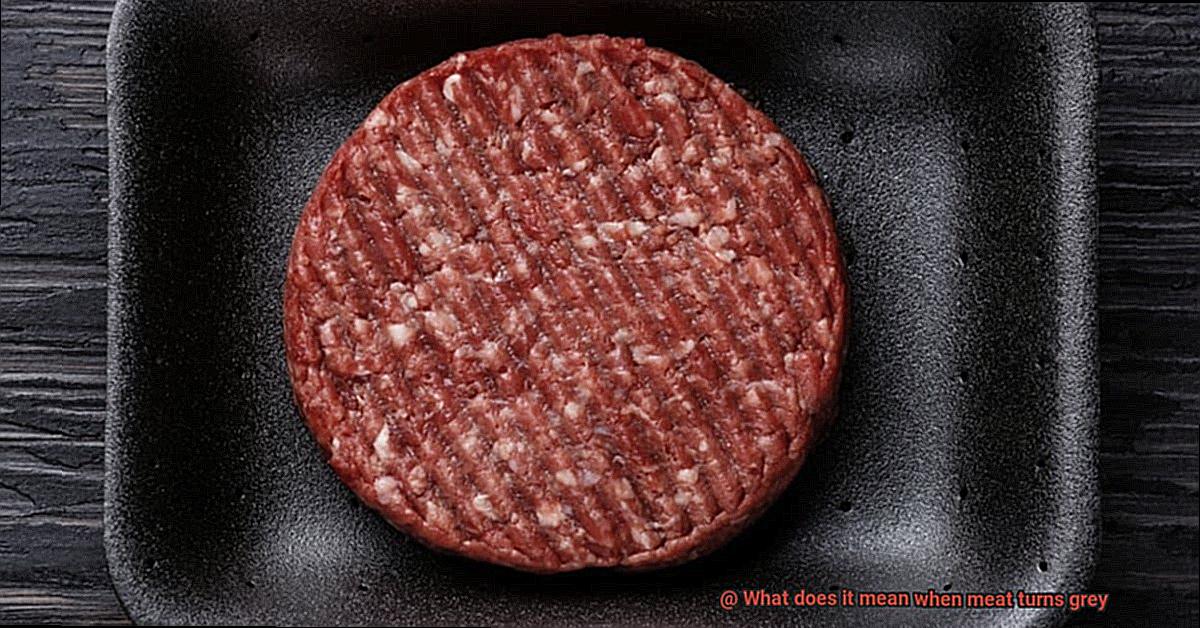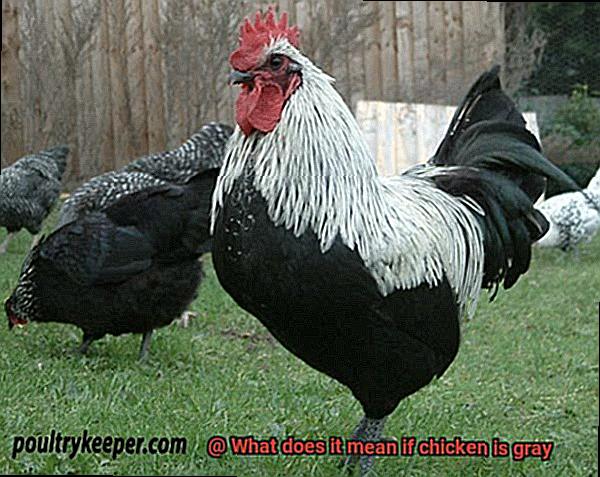- Picture this: you’re ready to cook up a juicy steak for dinner, but when you open your fridge, you’re met with a less-than-appetizing sight. The meat has turned a dull shade of grey. Cue the panic – is it still safe to eat? Fear not, my friends. As an expert in all things meat-related, I’m here to give you the lowdown on what it means when your meat turns grey.
- Let’s address the elephant in the room first: grey meat isn’t exactly Instagram-worthy. It can be off-putting and downright unappetizing for some people (myself included). But before you toss that steak out, let’s talk about what’s happening on a molecular level.

Fresh meat has a bright red color thanks to myoglobin, a protein found in muscle tissue. However, as the meat ages, myoglobin slowly breaks down and causes the color to change from red to brown or grey. This natural process is called oxidation and it’s completely normal.
- Now, here’s the million-dollar question: does grey meat mean bad meat? Not necessarily. In fact, many types of meat – especially beef – can still be perfectly safe to eat even if they’ve turned grey. That being said, it’s always important to use your senses when determining if your meat is still fresh. Give it a sniff and use your best judgment.
- In conclusion: don’t let grey meat scare you away from enjoying a delicious meal. While it may not look pretty, it doesn’t always mean that your food has gone bad. Just remember to trust your senses and use common sense when deciding whether or not to cook that steak tonight.
Contents
What Causes Meat to Turn Grey?
Don’t panic just yet. While it can be an indicator of spoilage, there are several reasons why meat can turn grey. Let’s explore the science behind this phenomenon and what you can do to prevent it.
Exposure to Air
One of the main reasons why meat turns grey is due to exposure to air. This process is called oxidation, where the oxygen in the air reacts with the myoglobin in the meat, causing it to lose its bright red color and turn brown or grey. While this process is natural and not harmful to consume, it can make the meat less visually appealing.
Improper Storage
Improper storage is another culprit behind grey meat. When meat is stored at temperatures above 40°F (4°C), bacteria can grow on the surface of the meat, causing it to spoil. As the bacteria multiply, they produce waste products that can cause the meat to turn grey or brown. To avoid this, make sure to store meat properly in a refrigerator or freezer at the appropriate temperature.
Bacterial Growth
Certain types of bacteria can also cause meat to turn grey. Pseudomonas bacteria, for example, can grow on the surface of meat and produce pigments that give the meat a greenish-grey color. Similarly, Lactobacillus bacteria can ferment the sugars in meat and produce lactic acid, which can cause the meat to turn grey.
Determining if Meat is Safe to Eat
If you’re unsure if grey meat is still safe to eat, use your senses as a guide. If the meat has a foul smell or slimy texture, it is likely spoiled and should be discarded immediately. On the other hand, if it still smells fresh and has no visible signs of spoilage, it may still be safe to eat.
Prevention
Prevention is key when it comes to avoiding grey meat. Proper storage and handling techniques can help prevent meat from spoiling too quickly. Make sure to store meat at the appropriate temperature and discard any meat that has gone bad. Additionally, cooking meat to the appropriate temperature can help kill any harmful bacteria that may be present.
Is Grey Meat Safe to Eat?
But before you toss it out, let’s explore whether or not it’s safe to eat. As an expert, I’ve researched and compiled some information to help you make an informed decision.
Firstly, oxidation is a common cause of grey meat. When exposed to air, the iron in myoglobin molecules can cause meat to turn grey. However, this doesn’t always mean that the meat is bad. It could just indicate that it has lost some of its freshness. On the other hand, if the meat is grey and has a foul odor or slimy texture, then it’s likely that the meat has gone bad and should be discarded immediately.
Secondly, proper storage is crucial to maintaining meat’s freshness and safety. Leaving meat out at room temperature for too long can cause it to become contaminated with harmful bacteria and organisms, which can cause it to turn grey and become unsafe to eat. To avoid this, always store your meat in the refrigerator or freezer and cook it thoroughly before consuming.
To summarize, while grey meat may not always be unsafe to eat, it’s important to use caution and assess the factors mentioned above before consuming it. Here are some key takeaways:
- Grey meat caused by oxidation may not necessarily be bad, but if it smells bad or feels slimy, discard it.
- Proper storage is crucial to maintain the freshness and safety of your meat.
- Always cook your meat thoroughly before consuming.
Natural Oxidation of Beef
Let’s start with the basics. Natural oxidation is a chemical process that occurs when meat is exposed to oxygen in the air. This means that when your beef turns grey, it’s a sign that natural oxidation has taken place. However, don’t fret just yet; this process is completely normal and happens to all meat products, including beef.
As your beef ages, it’ll start to darken in color due to the oxidation process. Depending on the degree of oxidation, the color of the meat can range from bright red to dark brown. But if your beef has been stored under ideal conditions, rest assured that it should still be safe to consume, without any off-putting odor or taste.
However, if you notice that your beef has turned grey with a sour smell or slimy texture, this could be an indication of spoilage. In such cases, it’s best to err on the side of caution and dispose of the meat, as consuming it could lead to food poisoning.
To prevent natural oxidation in your beef and extend its shelf life, proper storage techniques are crucial. The key is to limit exposure to air by keeping your beef in airtight containers or vacuum-sealed packaging. Additionally, make sure to store your beef in the coldest part of the refrigerator to keep it fresh for longer periods.
Identifying Spoiled Meat
Knowing the signs of spoiled meat is crucial to prevent food poisoning and other health risks.
Let’s start with the color of the meat. While some meats naturally turn greyish over time due to oxidation, slimy or foul-smelling meat is a clear sign that it’s no longer fresh. Trust your senses – if something looks or smells off, it’s likely spoiled.
Texture is another indicator of spoilage. If your meat feels sticky or tacky to the touch, it’s started to decompose and should not be consumed. Additionally, visible mold or discoloration on the surface of the meat is a definite red flag.
It’s also essential to check for sell-by or expiration dates on the packaging. Even if your meat doesn’t show any visible signs of spoilage, if it’s past its expiration date, it may have started to spoil.
When in doubt, throw it out. Consuming spoiled meat can lead to severe health problems. To prevent spoilage in the first place, store your meat properly in airtight containers and the coldest part of your fridge. It’s also crucial to wash your hands and any surfaces that come into contact with raw meat to avoid bacterial contamination.
In summary, here are some key takeaways:
- Check for sliminess, foul odor, mold, discoloration, and expiration dates to identify spoiled meat.
- Trust your senses when determining freshness.
- Store your meat properly and wash hands and surfaces to prevent bacterial contamination.
- When in doubt, throw it out.
- Properly store your meat by keeping it in the refrigerator at or below 40°F and wrapping it tightly in plastic or aluminum foil.
- Cook your meat thoroughly using a meat thermometer.
- Inspect the quality of the meat before purchasing.
- Always check for freshness by looking for bright red color and a slightly sweet aroma.
- Store raw meat at temperatures below 40°F (4°C) in the refrigerator or a cooler.
- Keep meat in its original packaging or an airtight container to prevent bacteria growth.
- Follow proper food safety guidelines when handling raw meat, including washing hands, using separate cutting boards, and cooking at appropriate temperatures.
- Pay attention to expiration dates and discard any meat that has passed its expiration date.
Preventing Grey Meat from Spoilage
Proper storage is the first step in preventing grey meat. Keeping your meat in the refrigerator at or below 40°F slows down bacterial growth and oxidation, which causes meat to turn grey. Wrapping your meat tightly in plastic or aluminum foil also prevents air from getting in and causing spoilage. Don’t let your meat sit in the fridge for too long, as the longer it sits, the higher the risk of spoilage.
Cooking your meat properly is also crucial in preventing spoilage. Use a meat thermometer to ensure that your meat has reached the appropriate temperature, and cook it all the way through. Not only will this prevent spoilage, but it will also destroy any harmful bacteria present in the meat.
When buying meat, inspect it for quality before making your purchase. Avoid purchasing meat with a greyish hue or off-odor, as these are signs of spoilage. Check the expiration date and packaging for any damage or leaks.
To sum up, here are some key points to keep in mind when preventing grey meat from spoilage:
Storing and Handling Techniques for Freshness
Not only does following these guidelines ensure the safety of your food, but it also guarantees that your meat will remain juicy and delicious.
First and foremost, fresh meat should have a bright red color and a slightly sweet aroma. If your meat appears grey or has a strange odor, it’s a clear indication that it has gone bad and is no longer safe to consume.
To keep your meat fresh, it’s crucial to store it at temperatures below 40°F (4°C). This can be achieved by keeping your meat in the refrigerator or a cooler. It’s also important to keep your meat in its original packaging or an airtight container to prevent bacteria growth.
When handling raw meat, always follow proper food safety guidelines. This includes washing your hands before and after handling meat, using separate cutting boards for meat and other foods, and avoiding cross-contamination. It’s also crucial to cook your meat to the appropriate temperature to eliminate any harmful bacteria.
In addition to these techniques, paying attention to expiration dates is vital. Meat that has passed its expiration date should not be consumed as it may have already begun to spoil.
To summarize, here are some key points to remember when storing and handling meat for maximum freshness:
ccIIKEtI1DM” >
Conclusion
To sum up, the discoloration of meat to grey is a natural process known as oxidation. This happens when the myoglobin in the meat breaks down and changes its color from red to brown or grey. However, it’s important to note that not all grey meat is unsafe for consumption. Despite its unappetizing appearance, several types of meats can still be perfectly safe to eat.
Nevertheless, it’s crucial to use your senses to determine if the meat has gone bad. If you detect a foul smell or slimy texture, then it’s best to discard it immediately.
Proper storage and handling techniques are also essential in preventing grey meat from spoiling. Keeping meat at temperatures below 40°F (4°C) and using airtight containers or vacuum-sealed packaging can limit exposure to air and prevent oxidation. Additionally, cooking the meat thoroughly can kill any harmful bacteria that may be present.
It’s equally vital to recognize the signs of spoiled meat such as mold, discoloration, sliminess, foul odor, and expiration dates. Trusting your senses when determining freshness is key.






